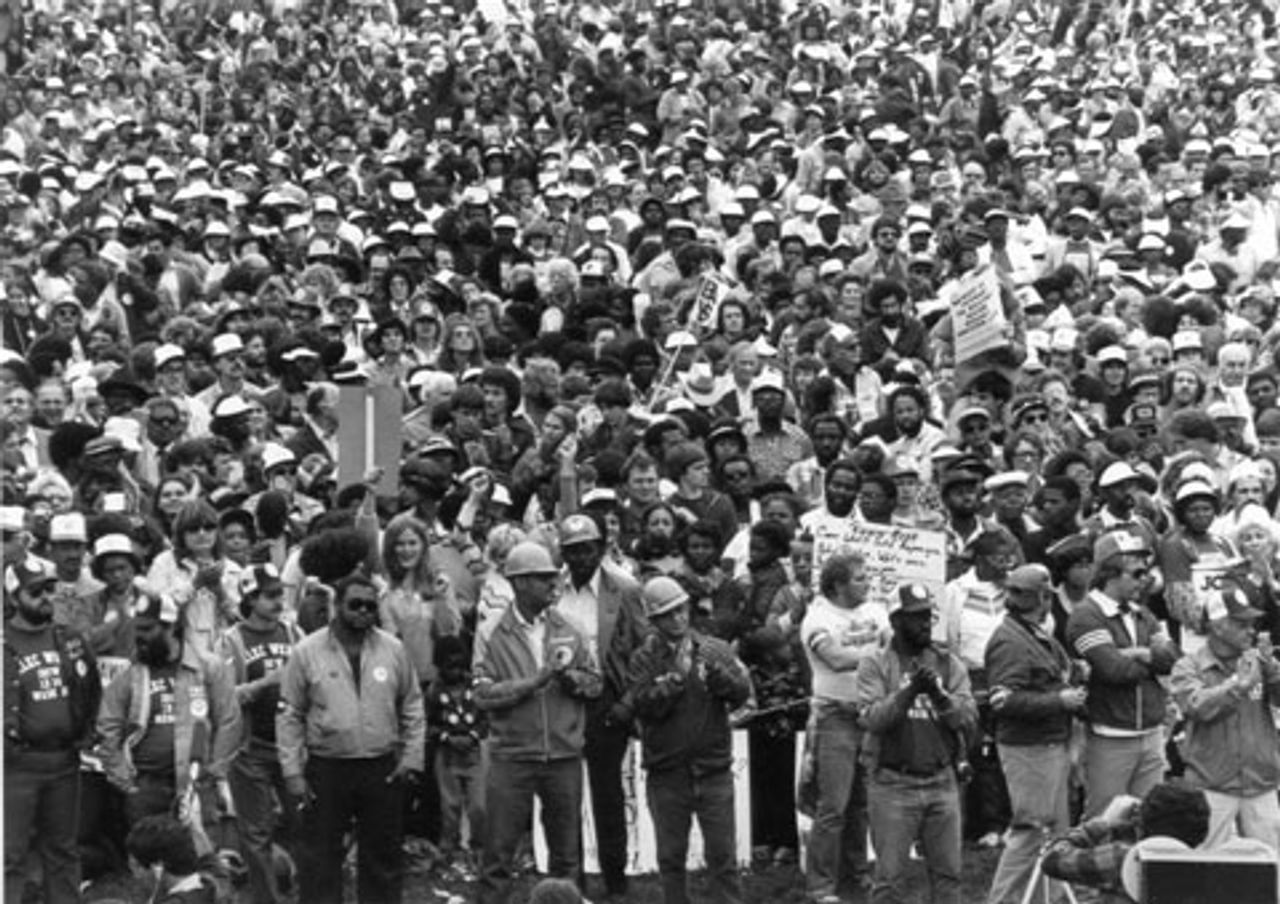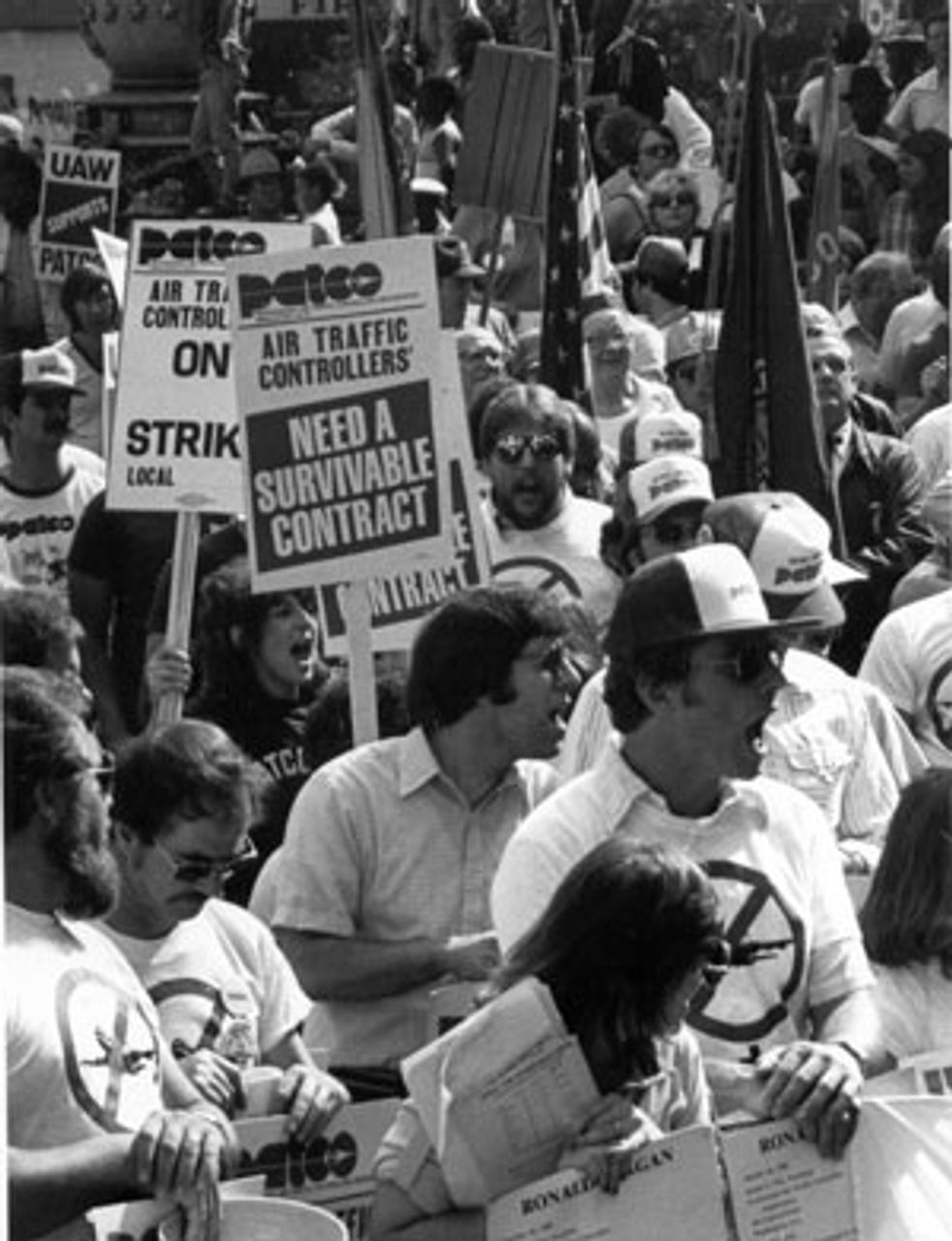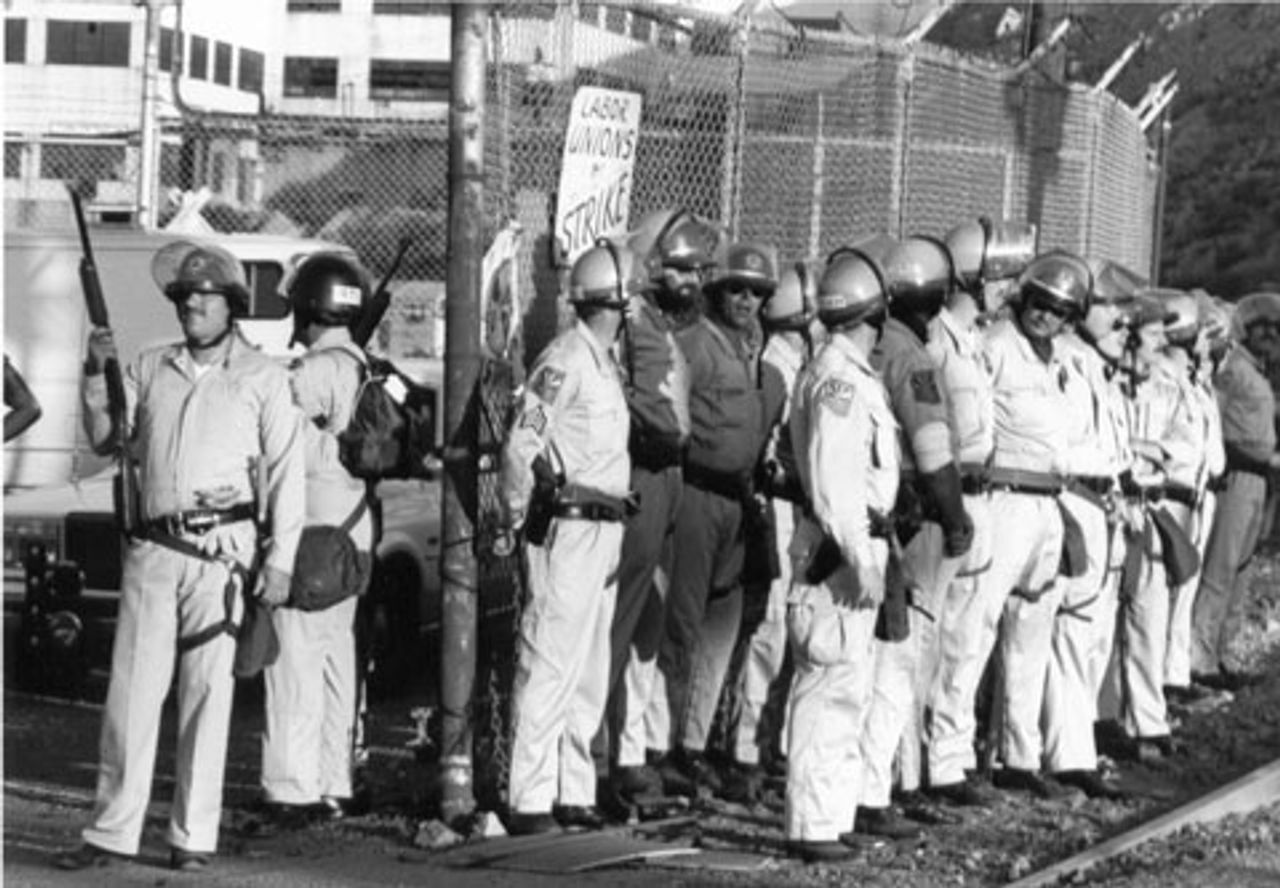PART ONE | PART TWO | PART THREE | PART FOUR | PART FIVE
On Augus t 3, 1981, 15,000 members of the union of air traffic controllers in the US—the Professional Air Traffic Controllers Organization (PATCO)—went out on strike against their employer, the Federal Aviation Administration (FAA). For years, employment levels and safety measures had failed to keep up with increasing commercial air traffic. Extreme stress forced a majority of controllers into early retirement. PATCO workers demanded a shorter workweek, increased wages and increased staffing.
 Solidarity Day, Washington DC, September 19, 1981
Solidarity Day, Washington DC, September 19, 1981Hours after they walked out, President Ronald Reagan, speaking from the White House Rose Garden, invoked the anti-strike Taft-Hartley Act to fire the strikers if they did not return to work within two days. The Reagan administration’s terms were simple: the ending of the strike and the total submission of the union to all White House demands. There would be no negotiations.
Air traffic controllers defied the back-to-work order en masse, with 12,000 to 13,000 remaining on strike. Yet in spite of their militancy and solidarity and deep support within the working class as a whole—expressed in the 500,000-strong Solidarity Day demonstration on September 19 in Washington DC—the struggle was isolated and betrayed by the AFL-CIO bureaucracy, which ordered members of other airline unions to cross the PATCO picket lines.
By the end of the year, it was clear that the air traffic controllers had been defeated. The Reagan administration and the courts outlawed the union, and all of the striking air traffic controllers were blacklisted from their profession for life.
The ferocity of the ruling class stunned workers. But Reagan’s ruthlessness—which included dozens of arrests and the jailing of four militant controllers in Texas—was enabled by the AFL-CIO bureaucracy. Though the threat posed by Reagan’s attack on the controllers to the entire labor movement was clear, the AFL-CIO steadfastly refused to authorize a broader working class mobilization, in spite of persistent calls for a general strike from workers. The unions instead sought to channel working class anger into support for the Democratic Party.
In reality, the union-busting operation was a bipartisan operation, carried out with the tacit support of the Democrats. The plan Reagan implemented for smashing PATCO, including the military scabbing operation known as the Management Strike Contingency Force, had been drawn up under Democratic President Jimmy Carter in 1980.
The AFL-CIO gave the Reagan administration assurances that it would do nothing in response to government strike-breaking and union-busting. In the face of pressure from workers calling for broader strike action in support of PATCO, AFL-CIO President Lane Kirkland said early in the struggle that he opposed “anything that would represent punishing, injuring or inconveniencing the public at large for the sins or transgression of the Reagan administration.” So confident was Reagan in the acquiescence of the labor bureaucrats, he delivered his August 3 back-to-work ultimatum even as the AFL-CIO Executive Council was meeting in New York City.
The government-organized destruction of PATCO was a signal to big business to launch a massive assault on the entire labor movement. Over the next decade, strike-breaking and union-busting operations were carried out in virtually every sector of the economy—air and ground transport, auto, steel, the mines, retail. Methods not seen since the 1930s were revived to crush the bitter resistance of workers to wage cuts and other concessions. The 1980s saw the reemergence of company goons, armed private police, labor frame-ups and violent attacks on picket lines. Every major strike battle was deliberately isolated and betrayed by the union leadership. The United Auto Workers, the AFL-CIO and virtually every other union adopted the policy of corporatism—the complete subordination of the working class to the corporations and the establishment of joint union-management structures to suppress the class struggle.
Thus, the betrayal of PATCO marked the collapse of the trade unions and their rapid transformation into agencies of the corporations and the state.
The Workers League, predecessor of the Socialist Equality Party, played a prominent role in the PATCO strike. Its defense of arrested workers earned the Workers League the support of many PATCO members. Reporters for the Bulletin, the newspaper of the Workers League and a forerunner of the World Socialist Web Site, interviewed dozens of strikers and their families in cities across the country.
The Workers League persistently called for widening the struggle to encompass the entire working class. It insisted that the conditions for expanding the strike could be achieved only through a political struggle against the union bureaucracy and the Democratic Party. The Workers League raised the demand for an emergency Congress of Labor to bring together unionized workers and unorganized sections of the working population for the purpose of establishing a Labor Party based on the unions to fight for a workers’ government and socialist policies. Without the initiation of such a struggle, the party declared, the PATCO strike could not be won. If the PATCO strike were allowed to be isolated and defeated, the Workers League warned, this would set the stage for an assault on the entire working class.
 Detroit PATCO strikers at the 1981 Labor Day rally
Detroit PATCO strikers at the 1981 Labor Day rallyWhile a strong sense of solidarity prevailed among workers—along with a desire for a showdown with the Reagan administration—the need for socialist political conceptions to guide the struggle was not broadly understood. This was itself a product of long historical processes. By the 1980s, decades of anti-communism promoted by the AFL-CIO had blocked many workers from knowledge of key historical experiences, including the decisive role socialists had played in building the industrial union movement in the 1930s.
The PATCO defeat sets off two distinct periods in US history. From the 1930s through the 1970s, the trade union movement in the US commanded significant authority in the working class. The victories of the industrial unions in the 1930s, the mass upsurge of the working class at the end of World War II, the persistence of large-scale strike activity through the 1950s and the 1960s, and the strike wave of the late 1960s through the mid-1970s—these had managed to wrest significant concessions from the American ruling class, which feared the emergence of working class revolution led by socialists, as had taken place in Russia in 1917. The epoch saw major improvements in living standards, the expansion of democratic rights to black workers in the South, and the creation of a limited welfare state.
The PATCO defeat established a pattern for every strike that followed in the 1980s and through the early 1990s. At Phelps Dodge, Greyhound, United Airlines, AT Massey, Hormel, Caterpillar, etc., workers carried on militant and bitter struggles. It was not for lack of fight that these and other strikes in the period went down to defeat. Rather, in each case the union bureaucracy consciously worked to isolate, demoralize and defeat the strikers.
 Troops at the Phelps Dodge mines, Morenci, Arizona, July, 1984
Troops at the Phelps Dodge mines, Morenci, Arizona, July, 1984Since the crushing defeats of the 1980s and 1990s, strikes have virtually disappeared in the US. The lack of organized resistance by the working class has whetted the appetite of the bourgeoisie, reflected in the staggering concentration of wealth in the US that has taken place since the 1970s. Steadily, the gains of the 20th century have been reversed, a process that has accelerated since the financial crisis of 2008 and the coming to power of the Obama administration.
The erosion of the membership rolls of the trade unions—down to their lowest share of the private sector workforce in more than a century—and the ongoing decline in the wages and wealth of working class Americans has not been reflected in a decline in the income and wealth of the union bureaucrats, thousands of whom award themselves salaries of more than $100,000 per year, and hundreds of whom take home upwards of $200,000. The unions have only deepened their integration into the Democratic Party, each election cycle funneling tens of millions of dollars to “friends of labor” who at every turn side with the corporations and the banks.
Thirty years on, it is clear that PATCO was one of a series of international events that signaled a global ruling class offensive against the working class. It presaged not only the collapse of the American trade unions, but of all the labor bureaucracies and political parties internationally that based themselves on nationalism and class compromise. The process that has culminated in the conversion of the American labor unions into business enterprises akin to labor syndicates was mirrored in the decision of the Stalinist bureaucracy in the Soviet Union at the end of the 1980s to complete its counterrevolutionary mission by liquidating the property relations established by the 1917 October revolution.
The far-reaching implications of the smashing of PATCO were well understood by the American ruling class at the time. Writing only days after the beginning of the strike, the Wall Street Journal editorialized that Reagan had to prevail over the air traffic controllers “for all sorts of far-reaching reasons that have absolutely nothing to do with relations between the Federal Aviation Administration and PATCO.” The more important issues, the editorial declared, were “commitments to rebuild military strength, to restore the dollar to soundness, to cut taxes and regulations, to resist Soviet imperialism, and to curb the wild ascent of federal spending.”
The Bulletin commented on August 11, 1981: “In short, the ruling class considers the destruction of PATCO as inseparable from its overall capitalist policy of defending the profit system with a program of unrestrained militarism internationally and savage austerity for the working class within the United States.”
Rosa Luxemburg said of the working class that “historical experience is its only school mistress.” She continued: “Its thorny way to self-emancipation is paved not only with immeasurable suffering but also with countless errors. The aim of its journey—its emancipation depends on this—is whether the proletariat can learn from its own errors.”
Drawing out the lessons of past defeats is a life-and-death matter for workers today. With PATCO, history exposed as unviable and bankrupt a labor movement that based itself on anti-communism, defense of the profit system, and nationalism. The aim of this review of the PATCO struggle is to extract the central political lessons of that experience in order to arm workers with the socialist perspective needed to insure victory in the mass struggles into which they are entering today.
To be continued
Subscribe to the IWA-RFC Newsletter
Get email updates on workers’ struggles and a global perspective from the International Workers Alliance of Rank-and-File Committees.
